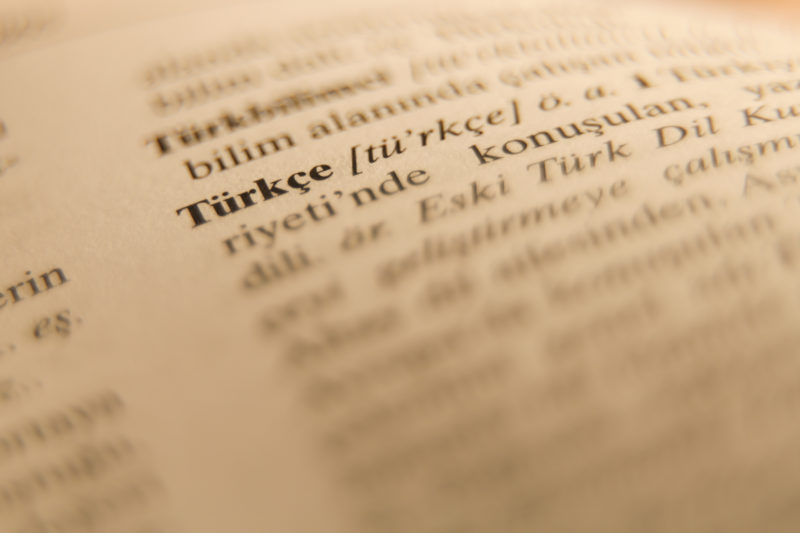Learn Turkish Grammar Easily
Nobody likes to learn grammar. It sounds like such a boring task. But, it’s necessary to reach fluency. Lucky for you, Turkish grammar is not difficult to understand at all. In fact, if you break down its components, it’s really fun and easy. So, here’s everything you need to know to master Turkish grammar: the basic Turkish rules, the nouns, suffixes, verbs, sentence structures, and much more.
The Basics of Turkish Grammar
Before we dive into the particulars, here are some basic rules in Turkish you need to follow. If you keep these in mind, learning Turkish will be much easier.
- Usually, a vowel follows a consonant. Two vowels or two consonants together is rare.
- Vowel harmony is important: specific vowels are grouped together when you speak Turkish
- When you attach a suffix to a proper noun, you need to separate the suffix and the noun with an apostrophe.
- Turkish has an SOV (subject-object-verb) sentence structure.
- Non-continuant voiceless consonants (p,ç,t,k) are sometimes voiced to make words easier to say
- ‘y’,’n’ and ‘s’ are buffer letters. They prevent two vowels to come after each other.

Master the Turkish Alphabet
The first step of learning grammar has to be mastering the Turkish alphabet. It’s fairly straightforward, but make sure you’re familiar with the spelling and pronunciation of all 29 letters. Luckily, both the Turkish and the English alphabet are based on Latin letters. So, most of them will be familiar to you. But, you need to pay special attention the modified letters, as these influence how Turkish nouns and suffixes interact.
As a refresher, here are all the special characters in terms of pronunciation in the Turkish alphabet:
- â, î and û: the little circumflex on top of these vowels serves two purposes. They’re either there to make the sound of the vowel longer. Or they’re there to distinguish words that have the same spelling, but different meaning. (kar /kar/ (snow), kâr /kʲar/ (profit))
- e: the pronunciation of “e” changes to [ɛ~æ] when it’s in front of the letters “m”, “n”, “l”, or “r”.
- g: the pronunciation changes to [ɟ] when it’s next to “e”, “i”, “ö” or “ü”
- k: the pronunciation changes to [c] when it’s next to e, “i”, “ö” or “ü”
- ğ: this letter is actually usually silent after “e” and “i”(değil [ˈde.il] (not)). Occasionally, it can be pronounced as [j] (eğri [ej.ˈɾi] (curve)). And finally, this Turkish letter also makes vowels longer (bağ [ˈbaː] (bond)).
- l: pronounced as [ɫ] when it’s next to next to “a”, “i”, “o” or “u”
- h: pronounced as [ħ] before consonants and at the end of words
- Q, X, W: these letters are not part of the Turkish alphabet because no Turkish word has them. But, you’ll see them in loanwords from English.
Nouns in Turkish Grammar
Here’s some good news for you: Turkish doesn’t have genders! That means that you don’t have to memorize whether a table or a chair is feminine or masculine. This makes Turkish much easier than French or German.
Otherwise, nouns are the same in Turkish as they are in English. They represent a person, place, thing, or idea. In Turkish, suffixes complete the nouns. These can signal location, profession, etc. They cal also make a noun into an adjective or verb. To reach Turkish fluency, you need to understand the logic and grammar behind Turkish suffixes.

The Grammar Behind Turkish Suffixes
Turkish is an agglutinative language. This means that you can add a letter or group of letters to the end of a word to modify its meaning. When you add suffixes to Turkish nouns, you create completely new words. This isn’t a new concept, but you definitely need to get used to how often it happens in Turkish.
For example, in English, you can clearly see agglutination: argue – argument – argumentative – argumentativeness. You add a group of letters to express a different idea. The same happens in Turkish. The prepositions “in”, “on”, “of”, and “by” are all attached to the end of the noun they belong to.
Common Turkish Suffixes
Turkish Suffixes |
English Equivalent |
Example |
-li |
with or
with the quality of or belonging to |
köylü = “villager”
sulu = “with water” atlı = “horseman” |
-siz |
without |
susuz = “without water” |
-çi, -ci |
profession |
gazeteci = “journalist”, çaycı = “tea seller”, dişçi = “dentist” |
-[y]ici |
habit |
yazmak = “to write”, so yazıcı = “writer” |
-çe |
-ish or as for |
çocukça = “childish[ly]”
türkçe = “Turkish” bence = “as for me” |
-(i)msi,
-(i)mtrak, -si |
-ish or -like |
duvarımsı = “wall-like”
beyazımtrak = “whitish” çocuksu = “child-like” |
-daş |
fellow- |
okuldaş = “schoolmate”
-daş does not follow vowel harmony |
-lik |
abstract noun formation |
büyüklük = “largeness” or “size”
susuzluk = “waterlessness” or “thirst” Granted, susuzluk is rather stilted, a Turk would more likely ask “Susadın mı?” for “Are you thirsty?” |
-igde, -ligi |
of the, similar to -lik |
|
-sel |
abstract adjective formation |
tarih = “history”, tarihsel = “historic” |
-ki |
abstract adjective formation |
sabahki hava = “morning weather”
Amerikadaki çocuklar = the children in America Ahmet’inki = “Ahmet’s” (with possessive) |
-ki |
added to genitive case to form a possessive pronoun |
Bu kalem benimki değil. = “This pencil is not mine (I do have a pencil, but this one is not it).”
Bu köpek benimki. = “This dog is mine.” |
-çik, -cik, -ceğiz, -ce |
Diminutive |
Ahmetçik = “my pal Ahmet”
Köyceğiz = “the dear little village” and a lakeside town in southwestern Turkey. |
-[y]iş |
Add to a verb stem for the noun form |
girmek = “to enter”, so giriş = “entrance”
çıkmak = “to exit”, so çıkış = “exit” |
-leyin |
by or at |
geceleyin = “by night”
akşamleyin = “at evening” |
-ken |
while |
yazarken = “while writing” |
-oğlu |
son of |
Köseoğlu Bey = “Mr Son-Of-The-Beardless-Man” |
You can find even more Turkish suffixes here.
Vowel Harmony
I’ve mentioned vowel harmony before, but what does Turkish vowel harmony mean? Well, you may have noticed that some suffixes changed their form in the examples:
-li = with / belonging to
- köylü = “villager”
- sulu = “with water”
- atlı = “horseman”
“-lü” and “-lu” aren’t the same as “-li”. That’s because of vowel harmony. In Turkish grammar, you need to match the vowel of the suffixes to fit with the word they’re attached to. So “ö” and “ü” are in the same category of pronunciation. Your mouth and vocal cords pronounce them similarly.
Vowel harmony in Turkish means that you need to match the vowels between words and their suffixes. This is a natural process to ensure the melody of the language remains consistent. As you’re progressing in your Turkish studies, you’ll get a natural feel for vowel harmony. Soon, you won’t even have to think about it.
The Grammar Behind Turkish Verbs
Verbs are the words that signal the action. You can conjugate verbs to fit the tense, case, speaker, or situation. Luckily, Turkish conjugation is consistent throughout the language. There are very few exceptions. It’s very important to note that when you’re saying Turkish verbs you don’t need to use pronouns. That’s because the pronoun is already in the verb’s conjugation.
Let’s take a look at a present tense conjugation of the verb “to jump”. The English pronouns are only there for guidance. All of these are present continuous. This means that the appropriate English translation would be “I am jumping” for “atlıyorum”.
Atlamak = to jump
Affirmative |
Negative |
Question |
Negative Question |
|
I |
atlıyorum |
atlamıyorum |
atlıyor muyum? |
atlamıyor muyum? |
you (sing.) |
atlıyorsun |
atlamıyorsun |
atlıyor musun? |
atlamıyor musun? |
he/she |
atlıyor |
atlamıyor |
atlıyor mu? |
atlamıyor mu? |
we |
atlıyoruz |
atlamıyoruz |
atlıyor muyuz? |
atlamıyor muyuz? |
you (pl.) |
atlıyorsunuz |
atlamıyorsunuz |
atlıyor musunuz? |
atlamıyor musunuz? |
they |
atlıyorlar |
atlamıyorlar |
atlıyorlar mı? |
atlamıyorlar mı? |
As you can see, there’s no difference between “he” or “she in Turkish. Let’s break it down how you can form Turkish verbs in the present tense:
Turkish Verb Conjugation: Affirmative in the Present Tense
- We take the infinitive (atlamak), and we cut off the last three letters, leaving only the root of the verb: atla
- Because the root ends in a vowel we neet to take that off too: atl
- The verb is not a product of etmek, gitmek, tatmak, gütmek so the root remains the same: atl
- According to the vowel harmony rule, we need to add “ı” in the place of “a”: atlı
- We add the appropriate ending for 1st, 2nd, or 3rd person in singular or plural:
-
- 1st person singular: yorum
- 2nd person singular: yorsun
- 3rd person singular: yor
- 1st person plural: yoruz
- 2nd person plural: yorsunoz
- 3rd person plural: yorlar
Turkish Verb Conjugation: Negative
- You take the infinitive (atlamak), and we cut off the last three letters, leaving only the root of the verb: atla
- Now you add the characteristic “m” for the negative form: atlam
- Due to vowel harmony, we have to add “ı”: atlamı
- You add the appropriate ending to fit the person and the plurality, just like before.
Turkish Verb Conjugation: Question
- To form the question, we take the 3rd person of affirmative: atlıyor
- For the question particle: We apply the Minor Sound Harmony rule on the last vowel: o and we get u, so the verb becomes: atlıyor muyum?
- To form the negative, we just take the 3rd person negative of affirmative: atlamıyor muyum?
It’s important to note that there’s no “to be” in Turkish. There is a “to exist”, but there’s no prominence of “to be” like in English. If you’re hungry, you conjugate the word for “to be hungry” (acikmak).

Turkish Adjectives
Adjectives are the descriptors of nouns. Whether you’re talking about the size of your house or the color of the sky, you need adjectives to describe them.
In Turkish, when you want to create comparatives (prettier) or superlatives (the prettiest) you need to add additional words to describe the exact degree of the comparison. Here are the most common adjectival degrees in Turkish, along with examples:
Turkish Positive Adjectival Degrees
Turkish Adjectival Degree |
English Translation |
çok |
too, very, many |
Çok pasta istiyor |
He wants a lot of cake |
Çok açsın |
You’re very hungry |
Çok çocuğum var |
I have many children |
en çok |
the most |
En çok para |
The most money |
En çok para Ali’de. |
Ali has got the most money. |
Tepede en çok ev var. |
Most of the houses are on the hill. |
daha |
more |
İki kahve daha, lütfen. |
Two more coffees, please. |
Daha sessiz olmalısın |
You need to be more quiet |
fazla |
too much, excessive |
Bana çok fazla verdin. |
You gave me too much |
Fazla para istediler. |
They wanted too much money. |
daha fazla |
much more |
Daha fazla yemek geldi. |
Much more food has arrived. |
Daha fazla para istediler. |
They wanted much more money. |
Turkish Negative Adjectival Degrees
Turkish Adjectival Degree |
English Equivalent |
az, biraz |
a little |
Az sonra çarşıya gidiyorum. |
I’m going to the shops a little later on. |
Biraz tuz istiyorum. |
I want a little salt. |
daha az |
more less(er) lesser |
Yemeğe daha az tuz koyunuz. |
put less salt on the food. |
Buralarda, daha az polis var. |
there are less policemen around here. |
pek az |
a bit less(er) very little |
pek az sigara kullanıyorum. |
I smoke (cigarettes) just a little. |
pek az şeker istiyorum. |
I only want a little sugar. |
çok az |
a lot less(er) |
çok az benzin kalıyor. |
just a small amount of petrol is left. |
çok az para istedi. |
he only wanted a very small amount of money. |
Turkish Sentence Structure Grammar
The grammar behind Turkish sentence structure is something you need to get used to. While English is an SVO (subject-verb-object) language, Turkish follows a SOV (subject-object-verb) sentence structure. A subject is the person or thing that does the action, a verb is the action, and the object is the person or thing that is affected by the action. Let’s take a look at an example here:
- Miriam eats an apple. – Miriam bir elma yiyor.
“Miriam” is the subject, “eats” (yiyor) is the verb, and “an apple” (bir elma) is the object. Turkish leaves the verb to the end of the sentence. This isn’t hard to grasp, but it definitely takes some time to get used to. And, if you want to create more complicated sentences, all you have to do is use Turkish conjunctions.
Turkish Conjunctions
Conjunctions are the words that let you create complex sentences. In English, these are words like “and”, “but”, or “also”. They all have their Turkish equivalents. Learning Turkish conjunctions isn’t comlicated. You just need to enhance your vocabulary with some common conjunctions, and use them to link two parts of the sentence together. Here are a few common Turkish conjunctions to get you started:
Turkish Conjunctions |
English Equivalent |
ve |
and |
veya
ya da |
or |
ki |
that |
de |
too, also |
Learn Turkish Grammar Naturally
Learning Turkish grammar can be very dry. But, you have to know these rules to speak Turkish fluently. Luckily, there’s a way to make grammar lessons fun and interesting: see all of these rules in everyday Turkish phrases. You can naturally discover the logic and grammar of Turkish. And to guide that journey, OptiLingo’s here to help.
OptiLingo is the app that gets you to Turkish fluency fast. By giving you the most common Turkish words and phrases, it teaches you exactly how the locals speak. Don’t waste time on boring grammar lessons again. To achieve Turkish fluency in a fun and exciting way, download OptiLingo today!











